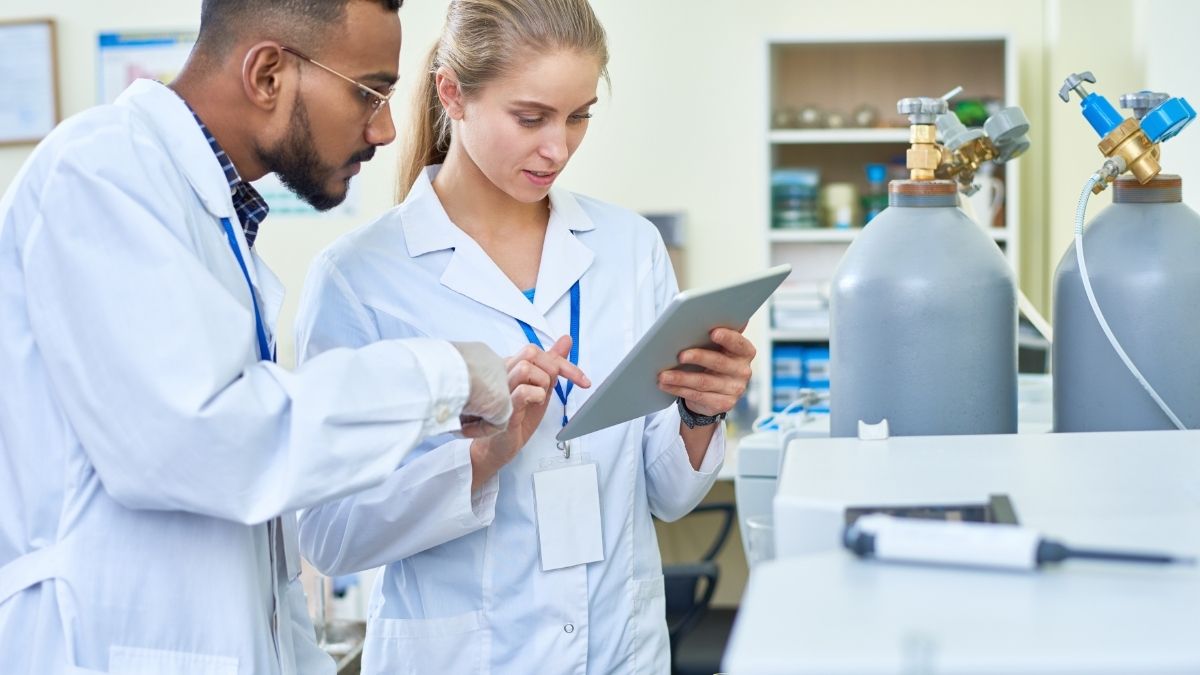Working with gas in laboratories can be a risky business. Most gas used in laboratories is contained in cylinders. Unsafe handling and procedures can lead to dangerous inhalation or even turn the cylinder into an explosive rocket. Here are a few safety tips to follow when working with gas in laboratories.
Storage
Gas cylinders should be stored properly to control the characteristics of the gas being contained. Flammable cylinders should be stored far from oxygen and hydrogen cylinders to eliminate the risk of fire, whereas all cylinders should generally be stored in cool, dry places to avoid vaporization and pressurization. Use appropriate chains or straps to secure stored cylinders in place.
Movement
Cylinders can be very heavy to move. A cylinder trolley is the best bet for the safe transportation of heavy cylinders around the laboratory to decrease movement. Excessive movement can create unwanted pressurization, which can make removing the cylinder cap highly dangerous. When moving cylinders, the cylinder should be securely strapped to the trolley or cart and the valve should be protected by a cap. It also may be wise to look into a Precise chemical transfer pump for pharmaceutical manufacturing when it is needed for larger requirements within a testing manufacturing lab.
Inspection
When using gas substances, be sure to inspect your cylinders and regulator often. Look for external or internal leaks, corrosive glass, and excessive grease or dirt build-up on the valves and regulator.
Identification
Always label compressed gases and be sure to read the label of the substances before using them. Make sure labels are legible, and do not rely solely on a cap label, as caps can be interchangeable. Before getting to work, you should be fully confident in the labeling of the substances you are using.
Gas cylinders carry compressed gas for laboratory usage; however, they can be highly dangerous if not handled with care. Some laboratories have made the switch to gas generators to minimize human contact and utilize automated safety features. If your laboratory is not equipped with a gas generator, be sure to follow storage, movement, inspection, and identification safety tips for working with gas in laboratories.










 Deering Estate
Deering Estate
 Massage Envy South Miami
Massage Envy South Miami
 Calla Blow Dry
Calla Blow Dry
 My Derma Clinic
My Derma Clinic
 Sushi Maki
Sushi Maki
 Sports Grill
Sports Grill
 The Healthy Kitchen
The Healthy Kitchen
 Golden Rule Seafood
Golden Rule Seafood
 Malanga Cuban Café
Malanga Cuban Café

 Kathleen Ballard
Kathleen Ballard
 Panter, Panter & Sampedro
Panter, Panter & Sampedro
 Vintage Liquors
Vintage Liquors
 The Dog from Ipanema
The Dog from Ipanema
 Rubinstein Family Chiropractic
Rubinstein Family Chiropractic
 Your Pet’s Best
Your Pet’s Best
 Indigo Republic
Indigo Republic




 ATR Luxury Homes
ATR Luxury Homes


 2112 Design Studio
2112 Design Studio
 Hamilton Fox & Company
Hamilton Fox & Company
 Creative Design Services
Creative Design Services
 Best Pest Professionals
Best Pest Professionals
 HD Tree Services
HD Tree Services
 Trinity Air Conditioning Company
Trinity Air Conditioning Company
 Cisca Construction & Development
Cisca Construction & Development
 Mosquito Joe
Mosquito Joe
 Cutler Bay Solar Solutions
Cutler Bay Solar Solutions


 Miami Royal Ballet & Dance
Miami Royal Ballet & Dance
 Christopher Columbus
Christopher Columbus
 Pineview Preschools
Pineview Preschools
 Westminster
Westminster
 Carrollton
Carrollton
 Lil’ Jungle
Lil’ Jungle
 Frost Science Museum
Frost Science Museum
 Palmer Trinity School
Palmer Trinity School
 South Florida Music
South Florida Music
 Pinecrest Orthodontics
Pinecrest Orthodontics
 Dr. Bob Pediatric Dentist
Dr. Bob Pediatric Dentist
 d.pediatrics
d.pediatrics
 South Miami Women’s Health
South Miami Women’s Health

 The Spot Barbershop
The Spot Barbershop
 My Derma Clinic
My Derma Clinic




 Miami Dance Project
Miami Dance Project

 Rubinstein Family Chiropractic
Rubinstein Family Chiropractic
 Indigo Republic
Indigo Republic

 Safes Universe
Safes Universe
 Vintage Liquors
Vintage Liquors
 Evenings Delight
Evenings Delight





 Atchana’s Homegrown Thai
Atchana’s Homegrown Thai
 Baptist Health South Florida
Baptist Health South Florida

 Laser Eye Center of Miami
Laser Eye Center of Miami
 Visiting Angels
Visiting Angels
 OpusCare of South Florida
OpusCare of South Florida

 Your Pet’s Best
Your Pet’s Best





 HD Tree Services
HD Tree Services
 Hamilton Fox & Company
Hamilton Fox & Company


 Creative Design Services
Creative Design Services